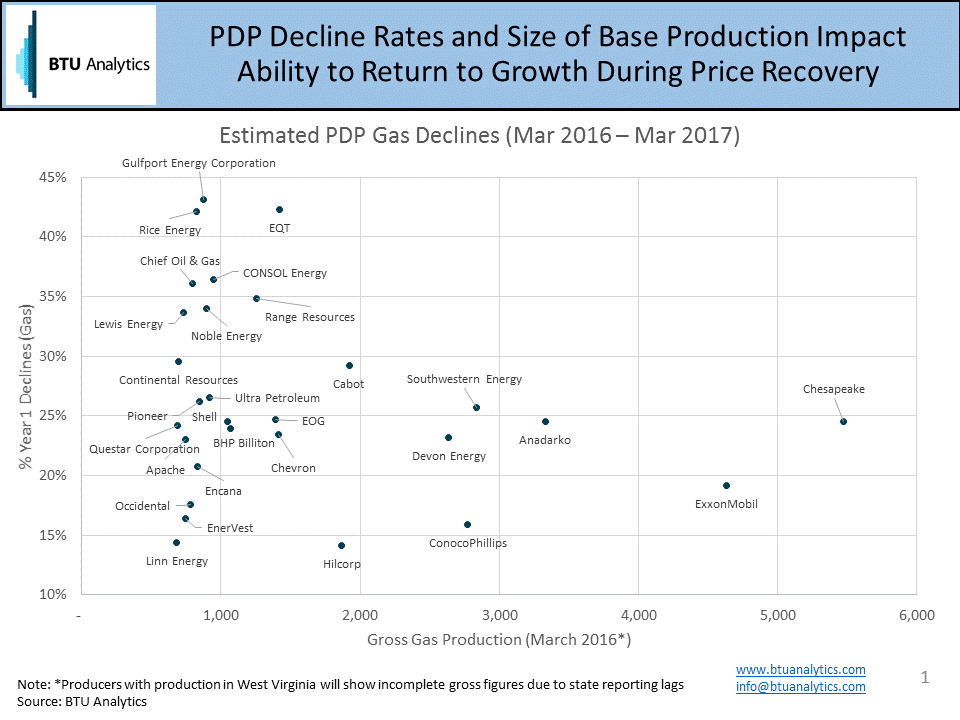With the crude and gas markets strengthening, knowing which E&P is best positioned to grow into this recovery is an opportunity not to be missed. E&P growth potential can be assessed using a variety of metrics, but four key metrics that will separate the winners from the losers are acreage quality, declines on existing production (PDP), scale of existing operations, and remaining drilling locations. In previous blogs, BTU Analytics discussed our well-level breakeven models that allow us to establish the quality of acreage held by various US producers. Producers with better acreage and lower breakeven costs already have a large advantage over those with higher cost acreage. However, it is also important to understand the underlying declines of any producer’s current assets. An E&P with steep declines in existing production needs to drill more wells to return to growth mode than a producer with shallower declines. In a market that rewards growth, the ability to quickly return to growth mode provides opportunities for larger returns.
In our new E&P Positioning Report, we estimated the annual declines on existing production for the top 30 operators of oil and natural gas production across the US. As producers battle to stem declines and switch to growth mode, having high PDP decline rates is like starting several steps back from the starting line in a 100 m dash. When every second counts, what seems like a small advantage or disadvantage has significant implications about who will win the race.
BTU Analytics estimated PDP decline by developing individual decline profiles for each operated well and then aggregating production from all of a company’s operated wells. The below graphic highlights the Year 1 decline rates (March 2016 to March 2017) for natural gas compared to each company’s total gross operated gas production. The range of PDP declines for natural gas is wide. ExxonMobil’s (NYSE: XOM) one year decline for operated natural gas is estimated at just 19% due to most of its gas production stemming from operating older gas fields. Conversely, Rice Energy (NYSE: RICE), which has experienced rapid growth developing the Marcellus and Utica, has an estimated one year decline rate of 42% based on operated production. On the oil side, Devon’s (NYSE: DVN) existing operated oil production is expected to decline by 43% between March 2016 and March 2017, while currently producing assets operated by California Resources (NYSE: CRC) would decline by just 12%.

All else equal, Devon and Rice would need to drill a higher percentage of new wells to offset declining production than ExxonMobil or California Resources. However, size of existing operations is also extremely important, ExxonMobil reported a gross gas production base of 4,636 MMcf/d in March 2016 which means they have to stave off 888 MMcf/d of declines to remain flat. Compared to a more modestly sized Rice, who needs to replace 347 MMcf/d of gas based on 824 MMcf/d of gross gas production in March 2016, and steeper first year gas PDP declines of 42%. Using a representative well for Marcellus with a gas IP rate of 9,000 Mcf/d and a 67% first year decline rate, Rice needs to drill and complete 5 wells/mo to maintain production levels as of March 2016. In 2016 Rice has been drilling 6.5 wells/mo. If they were to drill and complete all of these wells immediately then they would already be on track for production growth. Should the company add more rigs they are well positioned to have even higher growth.

Finally, in addition to rates of decline on existing production and scale of operations, a producer must have access to an inventory of quality future drilling locations. The number of remaining drilling locations is determined by the number of wells drilled historically in an area, well-spacing, stacked pay zones, and lateral lengths.
Looking at an acreage quality and inventory map of the Northeast side by side shows that while Rice has drilled the fewest wells on its acreage in southwest Greene County, historical results indicate this may be the least economic acreage within Rice’s portfolio. Looking at overall well economics across all operators, Washington and Belmont counties are more economic, but there are specific economic grid areas in Washington County that are starting to deplete remaining well locations (shown as white in grid) utilizing spacing assumptions of 90-acres in Southwest Appalachia and 120-acres in Appalachia Ohio.

Identifying E&Ps with the most growth potential based on the metrics of volume of producing base, declines on that base, acreage quality, and remaining economic drilling locations are just one of the key questions that BTU Analytics E&P Positioning Report seeks to answer. Next week, BTU Analytics will discuss how even a company that has high growth potential could be thwarted based on lack of access to demand markets.









